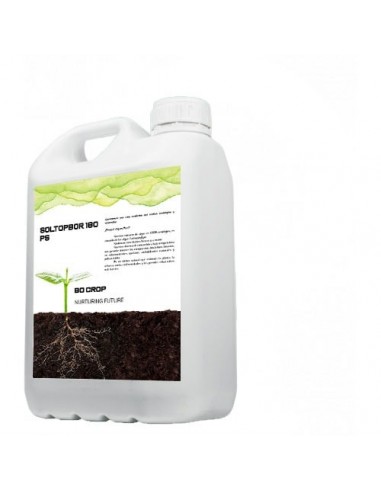Soltopbor 180 Ps
BORO ON THE PLANT
As a consequence of boron deficiency, small physiological changes in the plant produce large changes in the crops.
The lack of boron produces structural and functional changes in:
The cell membrane and cell division in meristematic tissues.
The conducting vessels (phloem and xylem)
Protein synthesis.
Cell growth and development of new roots, buds, flowers and fruits.
Formation and translocation of sugars, starch and carbohydrate metabolism.
The fertilization of flowers.
Transformation from inorganic to organic N
Resistance to attack by diseases and pests.
Due to these causes, the following are observed in crops: tissue breakage, fertilization failures, lower production, lower product quality, lower resistance to frozen droughts, diseases, insects; stem deformation, tissue necrosis, death of tips and tissues at growth points, deformed roots, poorly developed with less efficiency in absorbing nutrients and water; plants with evapotranspiration index higher than normal.
COMPOSITION:
• Boron (B): ............................................ .......................... 18.0% w / v
TECHNICAL SPECIFICATIONS:
APPEARANCE: White fine powder
Characteristic smell.
SOLUBILITY: Soluble in water
BENEFITS:
Increases flower set
Transport of photosynthates from leaves to fruits
Corrects boron deficiency in all organs of the plant
BORON ABSORPTION
The element boron (B) is absorbed as cation B (OH) 3 or anion B (HO) 4 - borate, by the roots when the properties of the soil such as texture, organic matter, pH and humidity are appropriate.
Foliar Way
Boron is absorbed via the leaves through the stomata, cuticle and ectodesm. Boron enters the stomata when gas exchange (O2 / CO2) takes place in the process of respiration and perspiration. The second route is through the cuticle; Boron, once it penetrates the cuticle, penetrates the cell walls of the leaves through the ectodesmata, which are spaces with a lower density of microfibrils and which are found in the area of ??the primary and secondary wall of the cells.
Foliar Way
Boron is absorbed via the leaves through the stomata, cuticle and ectodesm. Boron enters the stomata when gas exchange (O2 / CO2) takes place in the process of respiration and perspiration. The second route is through the cuticle; Boron, once it penetrates the cuticle, penetrates the cell walls of the leaves through the ectodesmata, which are spaces with a lower density of microfibrils and which are found in the area of ??the primary and secondary wall of the cells.

















